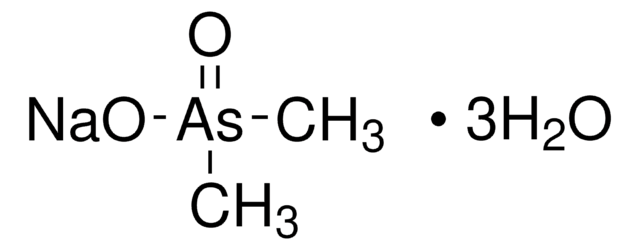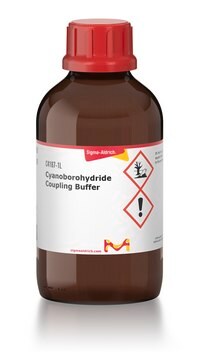Key Documents
G7651
Glutaraldehyde solution
Grade I, 50% in H2O, specially purified for use as an electron microscopy fixative or other sophisticated use
Synonim(y):
Glutaric dialdehyde solution, Pentane-1,5-dial
About This Item
Polecane produkty
Poziom jakości
typ
Grade I
Postać
liquid
stężenie
50% in H2O
metody
electron microscopy: suitable (fixative)
kolor
colorless
mp
-21 °C ((-6 °F))
rozpuszczalność
water: soluble
Warunki transportu
dry ice
temp. przechowywania
−20°C
ciąg SMILES
[H]C(CCCC([H])=O)=O
InChI
1S/C5H8O2/c6-4-2-1-3-5-7/h4-5H,1-3H2
Klucz InChI
SXRSQZLOMIGNAQ-UHFFFAOYSA-N
Szukasz podobnych produktów? Odwiedź Przewodnik dotyczący porównywania produktów
Opis ogólny
Zastosowanie
- along with 4-(2-hydroxyethyl)-1-piperazineethanesulfonic acid (HEPES) buffer to fix the concentrated extracellular vesicles (EVs) on concanavalin A for scanning electron microscope (SEM)
- as a component in a solution to fix the cells to observe its morphology
- to fix the Escherichia coli cells in aqueous solution to preserve the surface morphology of bacterial cells
Działania biochem./fizjol.
Cechy i korzyści
- Highly efficient and safe to use with lensed instruments, rubber, or plastics
- Non-corrosive to metals
- Minimum shelf life of 14 days
Inne uwagi
Oświadczenie o zrzeczeniu się odpowiedzialności
Hasło ostrzegawcze
Danger
Zwroty wskazujące rodzaj zagrożenia
Zwroty wskazujące środki ostrożności
Klasyfikacja zagrożeń
Acute Tox. 3 Inhalation - Acute Tox. 4 Oral - Aquatic Acute 1 - Aquatic Chronic 2 - Eye Dam. 1 - Resp. Sens. 1 - Skin Corr. 1B - Skin Sens. 1 - STOT SE 3
Organy docelowe
Respiratory system
Zagrożenia dodatkowe
Kod klasy składowania
6.1A - Combustible acute toxic Cat. 1 and 2 / very toxic hazardous materials
Klasa zagrożenia wodnego (WGK)
WGK 3
Temperatura zapłonu (°F)
Not applicable
Temperatura zapłonu (°C)
Not applicable
Wybierz jedną z najnowszych wersji:
Masz już ten produkt?
Dokumenty związane z niedawno zakupionymi produktami zostały zamieszczone w Bibliotece dokumentów.
Klienci oglądali również te produkty
Powiązane treści
Three-dimensional (3D) printing of biological tissue is rapidly becoming an integral part of tissue engineering.
Trójwymiarowe (3D) drukowanie tkanek biologicznych szybko staje się integralną częścią inżynierii tkankowej.
Nasz zespół naukowców ma doświadczenie we wszystkich obszarach badań, w tym w naukach przyrodniczych, materiałoznawstwie, syntezie chemicznej, chromatografii, analityce i wielu innych dziedzinach.
Skontaktuj się z zespołem ds. pomocy technicznej







